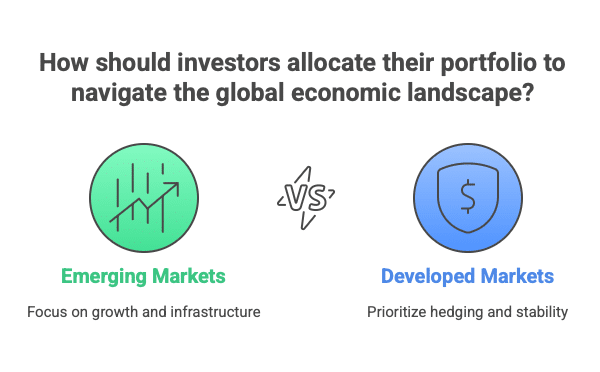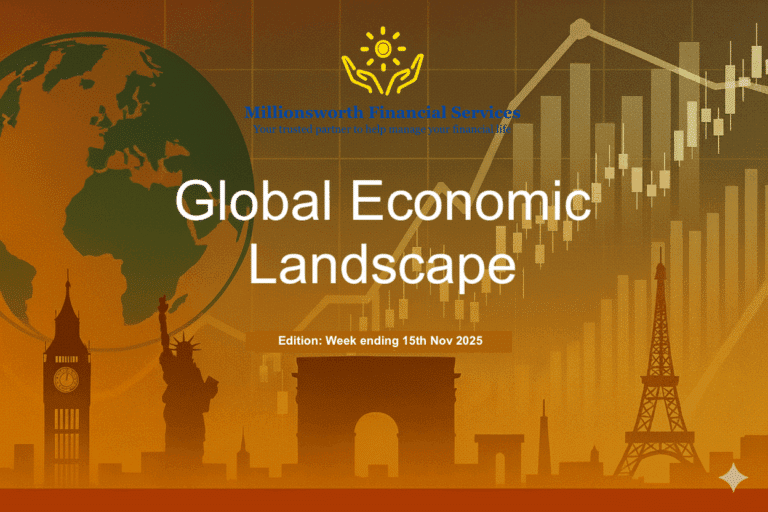The global economic landscape for the week ending October 11, 2025, revealed a striking divergence between East and West. While India solidified its position as a high-growth investment magnet with massive infrastructure commitments and structural reforms, major Western economies like the US and Eurozone continued to show signs of cooling and stagnation. A cautious U.S. consumer sentiment validated the Federal Reserve’s recent dovish pivot, strengthening the case for US Treasuries and defensive equity strategies. This week’s data is crucial for investors seeking to optimize portfolios for robust emerging market growth versus stability in developed markets facing domestic headwinds. Discover why the environment for Gold and Silver is particularly bullish and how these precious metals are shaping global investment strategies right now.
🇮🇳 India: Economic Superpower in the Making
The Indian economy is marked by strong growth projections, massive infrastructure investment, and regulatory streamlining. Key data includes a £500 million UK investment (Tide) and Rs 24,634 crore for railway projects, supporting the vision of India becoming the third-largest economy by 2028. Structural reforms like opening the electricity retail market, new EV policies, and launching the GIFT City foreign currency settlement system signal a pro-market shift. Banks maintain a stable outlook with low expected NPAs (2.3–2.5%).
- Equity: Strongly favour domestic cyclicals (construction, railway, power/utilities) and financial services. Strong services sector growth supports Fintech and IT.
- Bonds: Cautious of potential yield increases due to large government borrowing; focus on high-quality corporate or short-to-medium duration securities.
- Gold & Silver: Neutral to slightly positive. India’s economic growth and consumer wealth creation provide a long-term structural demand base for physical gold, though this week’s data is more focused on domestic industrial demand.
🇺🇸 United States: Stagnant Consumer Sentiment Validates Dovish Fed Pivot
The U.S. consumer data for October confirms a pessimistic household sector driven by high prices. The University of Michigan Consumer Sentiment Index remained flat at a low 55.0, and Consumer Expectations slipped to 51.2, signalling households are delaying major purchases. Although short-term inflation expectations eased marginally to 4.6%, they remain elevated. This data validates the dovish policy pivot.
- Equity: Shift away from discretionary consumer stocks toward defensive sectors and firms with pricing power.
- Bonds: Bullish trend for US Treasuries is strengthened, supporting lower long-term yields as the Fed’s easing is validated by economic weakness indicators.
- Gold & Silver: Highly Bullish. The dovish Fed and falling US Treasury yields (driven by weak expectations) weaken the U.S. Dollar and reduce the opportunity cost of holding non-yielding assets. Persistent, elevated inflation expectations (4.6%) further cement Gold as the preferred hedge against a depreciating dollar and negative real yields. Silver, with its dual role as a store of value, also benefits significantly.
🇬🇧 United Kingdom: Navigating Domestic Headwinds
The UK faces a cooling housing market and deep contraction in construction. The Halifax House Price Index slowed sharply to 1.3% YoY growth in September, and the Construction PMI remains deep in contraction at 46.2. The government, however, emphasizes a strategic partnership with India, signalling a reliance on international trade and service exports.
- Equity: Favour defensive stocks and large-cap companies with significant international revenue exposure, while actively avoiding domestically focused cyclicals exposed to the property and building sectors.
- Bonds: Cooling domestic sectors may reduce inflationary pressure, potentially supporting Gilt prices (UK government bonds), but this must be balanced against persistent core inflation.
- Gold & Silver: Positive. Weakness in the domestic economy and potential for reduced Bank of England rate hike expectations create a risk-off environment supportive of Gold.
🇪🇺 Eurozone: Slowing Momentum and Sectoral Contraction
The Eurozone is defined by softening demand and continued sectoral contraction. Retail sales slowed to 1.0% YoY growth in August (from 2.1%), and the Construction PMI fell further to 46.0 in September, confirming an intensifying contraction in capital expenditure.
- Equity: Maintain a defensive strategy, avoiding cyclicals linked to construction and real estate. Focus on non-cyclical consumer staples and services.
- Bonds: Slowing retail sales may reduce pressure on the ECB for further rate hikes, which is generally supportive of Eurozone government bond prices (Bunds).
- Gold & Silver: Positive. Broad economic weakness and deflationary risks increase demand for Gold as a reliable store of value outside the bloc’s currency, especially if the ECB remains hesitant to tighten.
🇯🇵 Japan: Exit from Deflation Gains Traction
Japan shows clear signs of rising corporate costs and accelerating domestic demand. The Producer Price Index (PPI) grew 2.7% YoY in September, and household spending accelerated to 2.3% YoY growth in August, confirming that price increases are being absorbed by consumers. The Leading Economic Index also rose, pointing to better future conditions.
- Equity: Heavily favour domestic-focused stocks, particularly retail and service-related companies. High PPI supports revenue for large-cap firms with pricing power.
- Bonds: Strong PPI and consumption increase the likelihood of BoJ monetary policy normalization, creating a headwind for JGBs.
- Gold & Silver: Mixed. While higher corporate costs (PPI) are generally supportive of inflation hedges, the prospect of a stronger Yen (due to BoJ normalization) could slightly pressure Yen-denominated Gold. However, the overall global inflation narrative remains highly supportive.
Millionsworth’s Perspective:
The theme for this week’s global economic data is clear: Resilience versus Retrenchment. While India’s pro-growth policies offer compelling reasons for investment in emerging market infrastructure and finance, developed markets are navigating a challenging cycle. For precious metals investors, the U.S. consumer data and the dovish Federal Reserveprovide a powerful, reinforcing signal: Gold and Silver are positioned for strength. Portfolio allocations must reflect the fundamental strength of emerging markets while prioritizing Gold and defensive equities to hedge against the persistent weakness and policy uncertainty driving the continued Divergence in Global Economic Landscape.




